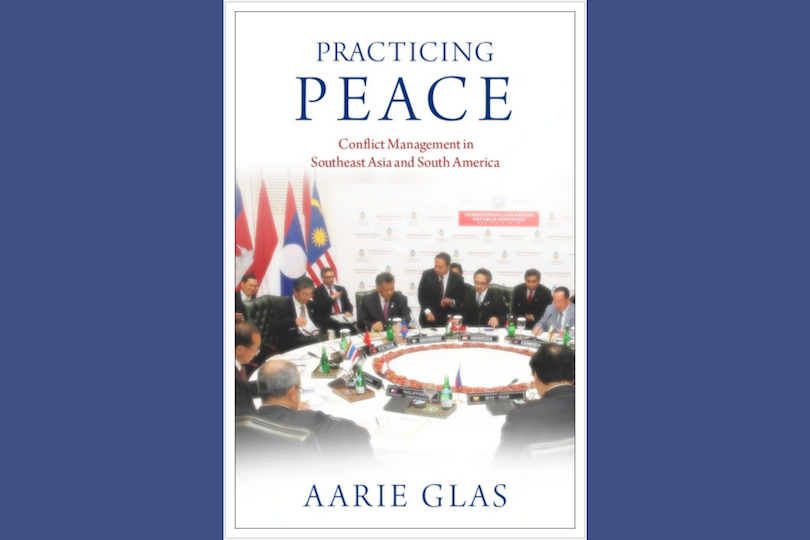Practicing Peace: Conflict Management in Southeast Asia and South America
FEATURED RESEARCH PAPER, 3 Jul 2023
Sarwar J. Minar | E-International Relations - TRANSCEND Media Service
Practicing Peace: Conflict Management in Southeast Asia and South America by Aarie Glas, Oxford University Press, 2022
25 Jun 2023 – With the rise of China and its increasing influence in various regions of the world (especially with a display of aggressive behavior in Southeast Asia recently), many scholars, academicians, and policy makers wonder how the transition of great power influence will affect regional peace and conflict dynamics, particularly in Southeast Asia, Africa, and Latin America. Dr. Glas highlights the exceptional ability of regional institutions from the Global South that can make a difference in peace and conflict management, adding a new dimension to a discussion typically dominated by Western [regional] institutions (e.g. the EU).
In his book, Dr. Glas explores the conflictual peace of Southeast Asia and South America, and offers a comparative perspective of the long-term foundation of peace in the two regions. The book provides indigenous insights on the practices of regional conflict management in the Global South. He seeks to answer the question:
“How have states managed conflicts for a long time without going to war, in the absence of conventional peace mechanisms, liberal democracy, regional hegemon, or liberal institutions?”
His main argument is that regional conflictual peace is the product of communities of practice that actively manage conflict and pursue regionalism in particular ways (p.22). In order to further this argument, he uses interpretive and social constructivist methodology (e.g., interviews).
The book is organized over six chapters.
The first chapter presents the central puzzle and existing alternative explanations centering around state power institutions and norms, and makes the case that those are only partial explanations for the coexistence of community building alongside sustained low levels of interstate violence.
The second chapter provides the central argument: habitual dispositions are at the heart of peace.
The third provides epistemological and methodological aspects: how habitual dispositions were discovered through interviews with diplomats and bureaucrats.
Chapters four and five provide supporting empirical evidence through two case studies: Southeast Asia and Latin America.
Lastly, the conclusion offers comparisons and contrasts between the two cases, showing the various paths to peace they pursued.
The author builds on Vincent Pouliot’s conception of peace. According to Pouliot, peace exists in and through practice, wherein security officials use their practical sense to make diplomacy a self-evident way to solve interstate conflicts (pp.2-3). Through rich interviews with state diplomats and officials in regional organizations, Dr. Glas makes the case that this is exactly what we see in the cases of the two regions.
Glas finds that regional interstate relations are strongly shaped by the habitual dispositions of the actors, by which he refers to a discrete set of processual and substantive qualities. He conceptualizes Community of Practice (CoP) as a discrete group of officials bound together by common enterprise and dense interaction, who share common tools and resources in pursuit of their goals. He shows that CoP is observable in both cases, as officials in each case understand and enact the norms and practice of conflict management and regionalism.
The author discovers seven habitual dispositions in Southeast Asia (i.e., habitual dispositions of prior consensus, informal dialogue, process over substance, non-interference, equality of members, face-saving, peaceful settlement of disputes) and four in the case of Latin America (i.e., rules-based,, formal dialogue, external mediation, and regional familiarity) (pp.198-199).
These distinct sets of habitual dispositions in each case shape diplomatic communities’ response to regional conflicts — this is how the officials successfully manage pervasive conflict short of war, as they attempt to respond to and resolve territorial disputes. Examples of this include the Preah Vihear dispute between Thailand and Cambodia in 2011 in Southeast Asia and the Cenepa conflict between Ecuador and Peru in 1995 in South America. This illustrates how conflict management diplomacy unfolds, and how peace is practiced within each diplomatic community, from government actors to organizational officials.
Some discussion on the origin and evolution of habitual dispositions over time would enrich the book. Moreover, there is no understanding provided of whether there is any preferential hierarchy among the habitual dispositions within a region. In other words, there is no hint as to whether certain sets of habitual dispositions played a more decisive role than others in a given case of dispute resolution.
The author is ambitious about the implications of the noble framework/findings as going beyond the two regions (p.207), but I am skeptical about its generalizability or applicability outside the regions of investigation, and even within the Global South, such as, for instance, in South Asia. The book focused more on Southeast Asia than South America — however, it does justice in covering both regions.
The book contributes to the theoretical understanding of long-term peace experienced by different communities of the world. It makes important contributions in cataloguing and making available to us the ways of conflict management and practicing peace in different regions of the world (Geertz 1973). The book also brings conflict management or peace practice of the Global South to the table and makes a unique contribution to the understanding of peace and conflict management in the two regions on their own terms.
Overall, the book contributes to further understandings of the elusive puzzle of why some regions enjoy long-term peace while others do not. The study has implications on the rise of China and emerging competition over the management of different regions of the world: in Southeast Asia, Latin America, and even Africa.
The book is very coherent, well organized, and nicely written. The language is very reader-friendly. I would highly recommend it for researchers, scholars, policy makers, and [graduate] students who are interested in norms and practice research, peace research, peace and conflict management, regional organizations, and in the regions of Southeast Asia and Latin America. The book is also a good resource for qualitative and interpretative research.
Reference:
Geertz, Clifford. 1973. “Thick Description: Towards an Interpretive Theory of Culture.” In The Interpretation of Cultures: Selected Essays. New York: Basic Books, Inc.
Further Readings:
- Navies and Maritime Policies in the South Atlantic
- The Rise and Fall of Peace on Earth
- Profit over Peace in Western Sahara
- Singapore Is Not An Island
- The Economic Consequences of the Peace
- Equal Opportunity Peacekeeping: Women, Peace, and Security in Post-Conflict States
_______________________________________________
 Sarwar J. Minar is a doctoral student at the Department of Politics and International Relations, Florida International University. His work focuses on international organizations, democratization, refugees, security, and foreign policy. Sarwar’s work has been published in Social Evolution and History, and Small Wars Journal, among others. He has presented his work at Midwest Political Science Association (2021, 2022), ISA-Midwest Political Science Association (2021), ISA-South St Augustine (2022), Florida Political Science Association (2023), and the 64th ISA Annual Convention, Montreal (2023).
Sarwar J. Minar is a doctoral student at the Department of Politics and International Relations, Florida International University. His work focuses on international organizations, democratization, refugees, security, and foreign policy. Sarwar’s work has been published in Social Evolution and History, and Small Wars Journal, among others. He has presented his work at Midwest Political Science Association (2021, 2022), ISA-Midwest Political Science Association (2021), ISA-South St Augustine (2022), Florida Political Science Association (2023), and the 64th ISA Annual Convention, Montreal (2023).
Tags: Africa, Conflict Resolution, Conflict studies, Peace, Peace Studies, Peacebuilding, Research, Reviews, South America, Southeast Asia
DISCLAIMER: The statements, views and opinions expressed in pieces republished here are solely those of the authors and do not necessarily represent those of TMS. In accordance with title 17 U.S.C. section 107, this material is distributed without profit to those who have expressed a prior interest in receiving the included information for research and educational purposes. TMS has no affiliation whatsoever with the originator of this article nor is TMS endorsed or sponsored by the originator. “GO TO ORIGINAL” links are provided as a convenience to our readers and allow for verification of authenticity. However, as originating pages are often updated by their originating host sites, the versions posted may not match the versions our readers view when clicking the “GO TO ORIGINAL” links. This site contains copyrighted material the use of which has not always been specifically authorized by the copyright owner. We are making such material available in our efforts to advance understanding of environmental, political, human rights, economic, democracy, scientific, and social justice issues, etc. We believe this constitutes a ‘fair use’ of any such copyrighted material as provided for in section 107 of the US Copyright Law. In accordance with Title 17 U.S.C. Section 107, the material on this site is distributed without profit to those who have expressed a prior interest in receiving the included information for research and educational purposes. For more information go to: http://www.law.cornell.edu/uscode/17/107.shtml. If you wish to use copyrighted material from this site for purposes of your own that go beyond ‘fair use’, you must obtain permission from the copyright owner.
One Response to “Practicing Peace: Conflict Management in Southeast Asia and South America”
Read more
Click here to go to the current weekly digest or pick another article:
FEATURED RESEARCH PAPER:

Comment from Alberto Portugheis:
All very interesting and I’m sure the book is worth reading. To me, however, it doesn’t matter ‘how’ we solve conflicts, but how we can “prevent” them.
Tragically, in a world dominated by the war industry, if a conflict does not end up in fighting and slaughter, it means the armed conflict will have to move to another destination.
Weapons, munition, explosives, missiles, tanks, air-fighters, warships, cost a lot of money to produce. The war industry employs millions. They all have to be paid their salaries at the end of each month. Politicians have no option. They don’t have to organise armed conflicts in their own country; they can easily arrange them in other countries. This is when diplomats come in handy. \this is why Embassies have their Trade and Military attachés.
Contrary to what people believe, diplomats have to do what their government wants them to do. For example, when Bush wanted to invade Iraq, the US Ambassador had to negotiate with Saddam Hussein’s government all details: first of all, if Iraq agreed to the invasion and fighting; then how much time was necessary for the Iraqi Armed Forces to get ready for the fight. Then date and time of the onset of the fighting.
To the world, however, diplomats have to lie; the Ambassador held regular Press meetings, to tell the world of his ‘efforts’ to avoid the war.
Franklin Delano Roosevelt – in a good position to know – said it very clearly: “No war is an accident. If there is war, it means the fighting parties agreed to it.”